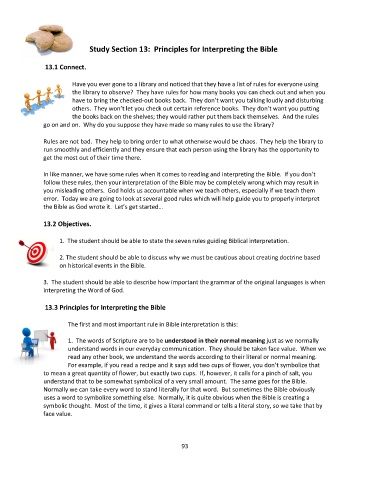Page 94 - Doctrine and History of the Preservation of the Bible Student Textbook
P. 94
Study Section 13: Principles for Interpreting the Bible
13.1 Connect.
Have you ever gone to a library and noticed that they have a list of rules for everyone using
the library to observe? They have rules for how many books you can check out and when you
have to bring the checked-out books back. They don’t want you talking loudly and disturbing
others. They won’t let you check out certain reference books. They don’t want you putting
the books back on the shelves; they would rather put them back themselves. And the rules
go on and on. Why do you suppose they have made so many rules to use the library?
Rules are not bad. They help to bring order to what otherwise would be chaos. They help the library to
run smoothly and efficiently and they ensure that each person using the library has the opportunity to
get the most out of their time there.
In like manner, we have some rules when it comes to reading and interpreting the Bible. If you don’t
follow these rules, then your interpretation of the Bible may be completely wrong which may result in
you misleading others. God holds us accountable when we teach others, especially if we teach them
error. Today we are going to look at several good rules which will help guide you to properly interpret
the Bible as God wrote it. Let’s get started…
13.2 Objectives.
1. The student should be able to state the seven rules guiding Biblical interpretation.
2. The student should be able to discuss why we must be cautious about creating doctrine based
on historical events in the Bible.
3. The student should be able to describe how important the grammar of the original languages is when
interpreting the Word of God.
13.3 Principles for Interpreting the Bible
The first and most important rule in Bible interpretation is this:
1. The words of Scripture are to be understood in their normal meaning just as we normally
understand words in our everyday communication. They should be taken face value. When we
read any other book, we understand the words according to their literal or normal meaning.
For example, if you read a recipe and it says add two cups of flower, you don’t symbolize that
to mean a great quantity of flower, but exactly two cups. If, however, it calls for a pinch of salt, you
understand that to be somewhat symbolical of a very small amount. The same goes for the Bible.
Normally we can take every word to stand literally for that word. But sometimes the Bible obviously
uses a word to symbolize something else. Normally, it is quite obvious when the Bible is creating a
symbolic thought. Most of the time, it gives a literal command or tells a literal story, so we take that by
face value.
93

